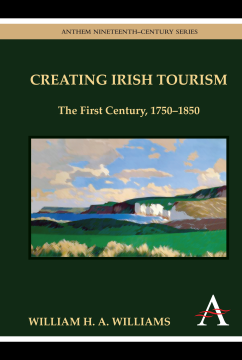
Additional Information
Book Details
Abstract
Although modern tourism did not begin in Ireland, it developed there rapidly after 1750, making the island one of the first counties in which tourism became a driving economic and cultural factor. Based on the accounts of British and Anglo-Irish travelers, this book charts the development of tourism in Ireland from its origins in the mid-eighteenth century to the country's emergence as a major European tourist destination a century later. Ireland presents an example of how modern tourism developed as a self-organizing system. There were no tourist boards, no planning commissions, no government grants and no consultants. Apart from some basic infrastructure, such as roads and hostelry, most of the elements needed to support tourism in Ireland emerged without over-arching planning, and coordination largely through the generally uncoordinated actions of landlords, entrepreneurs, and the peasantry.
Given its scenic attractions and proximity to Great Britain, Ireland’s position as a tourism Mecca might seem inevitable. Yet tourism in Ireland, as anywhere else in the eighteenth century, had to be invented. Mountains and lakes had to be reconfigured in the public imagination as tourist sites. Through the descriptive accounts of travel writers the sites had to be identified and defined in ways that made them attractive and meaningful to potential visitors. Landlords often opened and organized the sites for visitors. However, the actual activities on the ground - what the tourists viewed and experienced - evolved out of the interaction between the visitors and the veritable army of peasant guides, jarvies, vendors, porters, and beggars who greeted and served them. These contacts combined with British stereotypes regarding the Irish to create distinctly 'Irish' tourist experiences.
In addition to period travel writing, this work draws upon recent scholarship in the fields of tourism and travel studies to produce the first investigation of the history of the initial century of Irish tourism.
'Meticulously researched and elegantly written… It would be difficult to underestimate the work’s importance for any serious student of Irish history and culture or indeed for anyone with an interest in the birth of tourism as a global phenomenon.' —Michael Cronin, Director of the Centre for Translation and Textual Studies, Dublin City University, Ireland
Based on the accounts of British and Anglo-Irish travelers, ‘Creating Irish Tourism’ charts the development of tourism in Ireland from its origins in the mid-eighteenth century to the country's emergence as a major European tourist destination a century later. The work shows how the Irish tourist experience evolved out of the interactions among travel writers, landlords, and visitors with the peasants who, as guides, jarvies, venders, porters and beggars, were as much a part of Irish tourism as the scenery itself.
'A splendid account of early Irish tourism… This ground-breaking study shows why places such as Killarney and the Giant’s Causeway, as well as lesser-known Irish sites, should occupy a central place in tourism history.' —Kevin J. James, Associate Professor, Department of History, University of Guelph, Ontario, Canada
'A survey that brings historical detail, literary analysis and the wider cultural context wonderfully together…an admirably clear, concise and informative read.' —Glenn Hooper, Research Fellow, Open University, UK, and author of 'Travel Writing and Ireland, 1760-1860'
William H. A. Williams completed his PhD from the Johns Hopkins University in Baltimore, Maryland in 1971. He has since worked as a lecturer, project director, and educational consultant, and has retired as Professor Emeritus from the Union Institute, College of Undergraduate Studies in Cincinnati, Ohio. His recent publications include 'Tourism, Landscape and the Irish Character: British Traveling Writing in Pre-Famine Ireland, 1750-1850'.
Table of Contents
| Section Title | Page | Action | Price |
|---|---|---|---|
| Cover | i | ||
| Front Matter | ii | ||
| Half title | ii | ||
| Series page | iii | ||
| Main title | iv | ||
| Copyright page | v | ||
| Dedication | vi | ||
| Table of Contents | viii | ||
| Preface | x | ||
| Introduction | xii | ||
| Main Matter | 1 | ||
| Part I | 1 | ||
| Chapter 1. GETTING THERE AND GETTING ABOUT | 3 | ||
| Chapter 2. TOURS GRAND AND PETITE | 27 | ||
| Chapter 3. PROPERTY, CLASS AND IRISH TOURISM | 49 | ||
| Part II | 67 | ||
| Chapter 4. THE SUBLIME AND THE PICTURESQUE IN THE IRISH LANDSCAPE | 69 | ||
| Chapter 5. PICTURESQUE TOURIST SITES IN IRELAND | 89 | ||
| Chapter 6. THE TOURIST EXPERIENCE | 107 | ||
| Chapter 7. KILLARNEY—A CASE STUDY OF THE IRISH TOURIST EXPERIENCE | 129 | ||
| Part III | 151 | ||
| Chapter 8. TOURIST SEMEIOTICS, STEREOTYPES AND THE SEARCH FOR THE EXOTIC | 153 | ||
| Chapter 9. ON THE ROAD—IN SEARCH OF IRELAND | 165 | ||
| Chapter 10. THE FAMINE AND AFTER | 183 | ||
| CONCLUSION | 193 | ||
| End Matter | 199 | ||
| Notes | 199 | ||
| Bibliography | 227 | ||
| Index | 245 |
